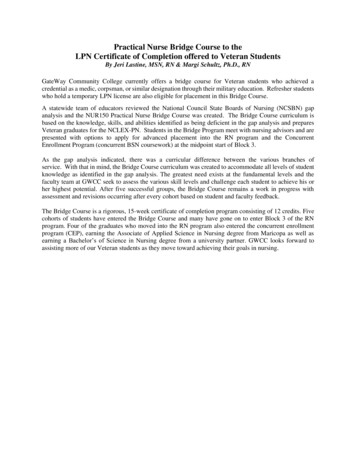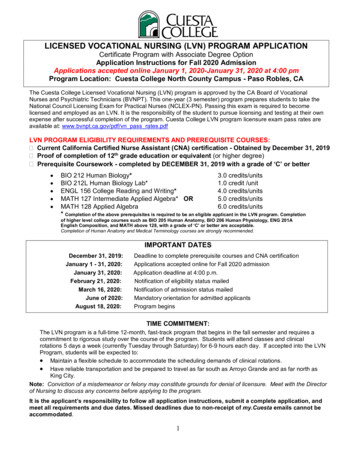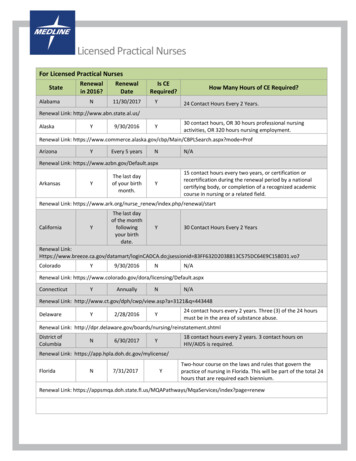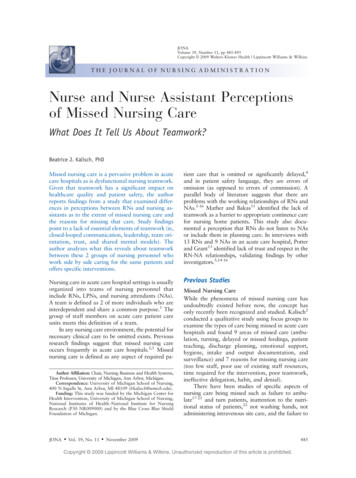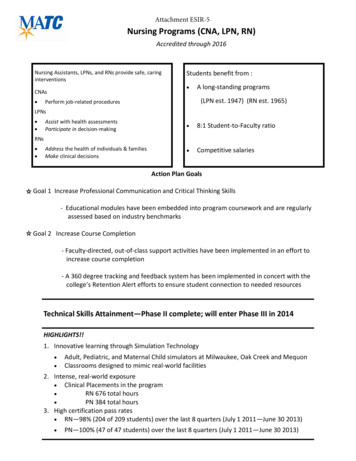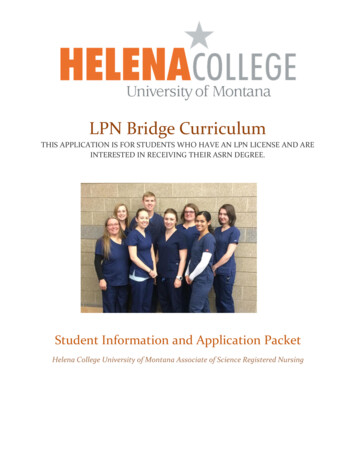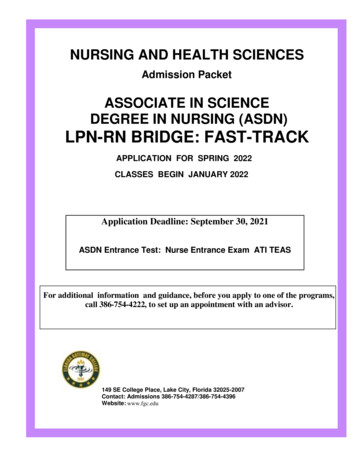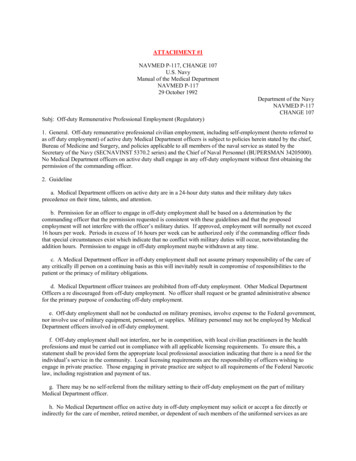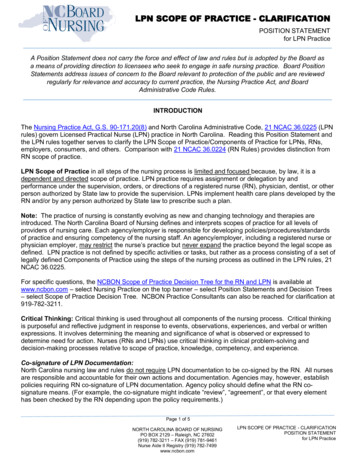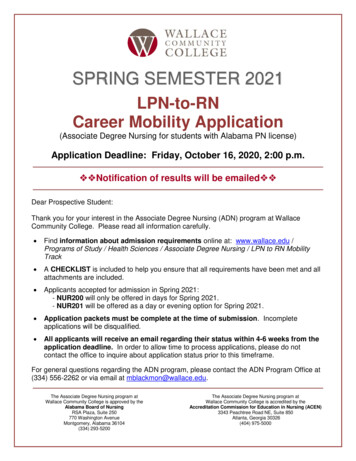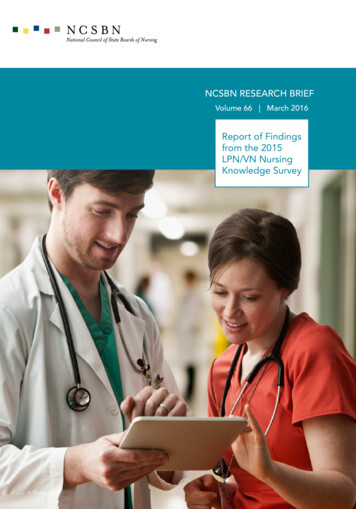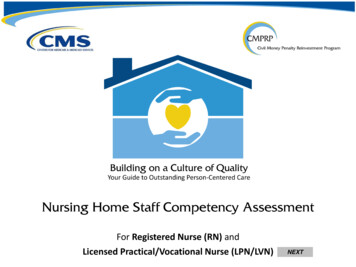
Transcription
For Registered Nurse (RN) andLicensed Practical/Vocational Nurse (LPN/LVN)NEXT
Competency assessments are an important tool to: Identify your strengthsHighlight growth areas by analyzing your and your team’s learning needsEncourage professional development through discussions between you and your supervisorIncrease job satisfaction, which leads to higher quality of care and life for residentsThis situation-based, multiple choice assessment consists of three sections:BehavioralTechnicalResident-BasedThe assessment should take you about 1 hour to complete, and the results will: XXHELP you share professional strengths and growth areas with managementHELP your facility continue to build a culture of quality care for residentsNOT be used against youNOT be shared with federal or state officials/surveyorsPREVIOUSNEXT
123xCOMPLETE COMPETENCYASSESSMENTYOUR SUPERVISOR REVIEWSASSESSMENT RESULTSDISCUSS ASSESSMENTRESULTS WITH YOURSUPERVISORBEFORE YOU BEGIN1. ASK where you should save the assessment file (such as desktop folder, shared drive, flash drive).2. SAVE the file with your FIRST and LAST NAME as part of the file name.3. CLICK “File,” then click “Save” as you complete each section of the assessment.PREVIOUSNEXT
123xCOMPLETE COMPETENCYASSESSMENTAFTER YOU FINISHYOUR SUPERVISOR REVIEWSASSESSMENT RESULTSDISCUSS ASSESSMENTRESULTS WITH YOURSUPERVISORYour supervisor will meet with you to review your results, answer anyquestions you have, and identify how leadership can help you addressyour competency growth areas.Helpful tips before you meet with your supervisor:1. REVIEW YOUR RESULTS: Identify any questions or competency areas you want to discuss.2. BE PREPARED: Prepare to share strengths and growth areas, and come with ideas on how you candevelop professionally.3. BE OPEN TO FEEDBACK: Your position requires continuous learning to provide residents with thehighest quality of care. This is an opportunity to learn and your supervisor is there to support you.PREVIOUSNEXT
This gives you a brief descriptionof the section you are viewing.Click on the circle next tothe answer you want to select.You will know the selection is completewhen the circle turns black.Use this bar totrack your progressthrough the assessment.PREVIOUSClick the 'NEXT‘ and‘PREVIOUS’ buttons tomove between pages,Do NOT use the scroll bar.NEXT
1. READ each question carefully, and consider the topic and answer choicesbefore selecting your response.2. NOTE any question(s) that you may want to discuss with your supervisor.3. SIGN the last page in each of the three sections to confirm your answers.4. DISCUSS your results with your supervisor.Please enter your FIRST and LAST NAME below (REQUIRED):Please select your position:Registered Nurse (RN)PREVIOUSLicensed Practical/Vocational Nurse (LPN/LVN)NEXT
Please SAVE the assessmentif you have not done so alreadyRemember to:1. SAVE the file with your FIRST and LAST NAME as part of the file name.2. CLICK “File,” then click “Save” as you complete each section of the assessment.If you are in a web browser*:1. SAVE the file with your FIRST and LAST NAME as part of the file name.2. CLOSE the file in the web browser.3. OPEN the file from the saved location.*Responses will not be saved if you complete the assessment in the web browser.PREVIOUSNEXT
PREVIOUSNEXT
Ensures the resident has active participation in all parts of his/her own health care (i.e., right to self-determination, right toaccess to information and privacy, preferences for care, decisions). Represents the resident when requested or when the residentis not able to advocate for one’s self. Promotes staff education on resident rights and the responsibilities of the facility to ensureservices enhance care within the organization.1.Your unit will begin using a new IV pump and the training isscheduled for 15 minutes before the end of your shift. You:4.A. Complete your work in time to attend the training so thatyou fully understand the capabilities of the new equipment.B. Ask your coworkers to tell you what they learn.2.C. State that pumps are all the same and that you will figure itout when the pump gets to the unit.A. Believe in time the resident will adjust and donothing for now.D. Hope you never have to use it.B. Share the resident’s status with the interdisciplinaryteam and support finding a better solution for theresident.Professional standards include providing person-centered care. Anexample of person-centered care is:C. Tell the daughter her father is depressed becauseshe made him move.A. Follow a plan of care that is the same for every person.B. Follow a plan of care that respects the unique needs ofeach individual.C. Follow a plan of care that makes work easy for the staff.D. Follow the same plan of care for all residents, due to limitedtime.3.You notice a resident has started coming out of his room lessand seems depressed (e.g., loss of interest, persistent sadness,isolation, etc.) since he moved to your unit from a unit wherehe lived for many years. He tells you he wants to go back tohis old unit with his friends. You know his daughter requestedthe unit change. You:Development of a pressure ulcer/injury related to failure to turnand reposition a resident can be defined as:A. Physical abuse.B. Financial abuse.D. Tell the resident the move was for his own good andthat he will get better care on your unit.5.As a professional nurse in an interdisciplinary team, you:A. Share information about a resident’s change incondition with a treating therapist.B. Participate in making sure that the resident’s plan ofcare reflects the resident’s preferences, choices andgoals.C. Neglect.C. Communicate orders for diet changes with thedietary team.D. Emotional abuse.D. All of the above.PREVIOUSNEXT
Ensures the resident has active participation in all parts of his/her own health care (i.e., right to self-determination, right toaccess to information and privacy, preferences for care, decisions). Represents the resident when requested or when the residentis not able to advocate for one’s self. Promotes staff education on resident rights and the responsibilities of the facility to ensureservices enhance care within the organization.6.An alert and oriented resident wants to self-administer her medication. This requires completing a self-administration of medicationassessment, changing medication storage, updating the care plan and involving the interdisciplinary team to make sure she is safely ableto manage her medication. Additionally, you need to ensure it is documented daily that the medication is taken as prescribed. You:A. Tell her it is easier on the staff if she allows the staff to manage her medication.B. Support her decision and begin the process to make sure she can manage her medication safely.C. Tell the Director of Nursing Services (DON/DNS) you do not want to do it because it is time consuming.D. Ask the resident’s family member to convince her to change her mind.7.In your role as an advocate for residents, you:A. Assist the resident in scheduling and getting to medical appointments.B. Make sure to record resident’s medication information, including last dose and allergies. You include this information intransfer documents when the resident is sent to the hospital.C. Help the resident understand information about new medications.D. All of the above.8.The definition of nursing autonomy is: “The ability to act according to one's knowledge and judgment, providing nursing care within thefull scope of practice as defined by existing professional, regulatory and organizational rules.” This means:A. You may administer an anti-hypertensive medication and monitor for effect if the resident’s blood pressure is elevated andmeets the parameters of the physician’s order.B. You may order labs without a physician’s order for a resident with an elevated temperature.C. You may administer two Tylenol tablets without an order to a resident with an elevated temperature, as long as youdocument in the nurse’s notes that the medication was administered using the “rights” of medication administration.D. You may administer a one-time dose of Milk of Magnesia to a resident complaining of constipation without a physician’sorderPREVIOUSNEXT
Interacts and effectively communicates with residents, families and staff while “fostering respect and shared decision-making” inorder to improve residents’ care coordination and satisfaction. Utilizes communication technology and knowledge of the Englishlanguage to read, write and speak effectively with others in order to convey and understand information and ideas clearly. Utilizeseffective communication skills such as active listening, providing feedback and full attention, addressing emotional behaviors andbarriers, resolving conflict and understanding the role diversity and aging can play in communication.1.Conversations regarding advanced directives should occur:A. On admission.B. During care plan meetings.C. When there is a change of condition.D. All of the above.2.The following strategies should be used when communicating with people who have speech or language difficulties:A. Sit or squat to be at eye level and make eye contact.B. Allow extra time for communication.C. Use gestures or a pen and paper to draw or write.D. Finish the person’s sentences so they don’t get frustrated.E. A, B and C.3.Your participation in interdisciplinary team meetings and documentation of medical records is:A. Very important.B. Not Important.C. Neutral.PREVIOUSNEXT
Interacts and effectively communicates with residents, families and staff while “fostering respect and shared decision-making” inorder to improve residents’ care coordination and satisfaction. Utilizes communication technology and knowledge of the Englishlanguage to read, write and speak effectively with others in order to convey and understand information and ideas clearly. Utilizeseffective communication skills such as active listening, providing feedback and full attention, addressing emotional behaviors andbarriers, resolving conflict and understanding the role diversity and aging can play in communication.4.How would you handle communicating with the emergency room during the transfer of care of a resident? Select theappropriate hand off method:A. Tell the ambulance provider that you will fax the paperwork later.B. Copy and provide documents based on your facility’s transfer protocols.C. Give a verbal report to the accepting emergency department nurse before transferring the resident.D. B and C.5.What should you know when observing and interpreting a resident’s nonverbal communication?A. Patients are usually aware of his/her nonverbal cues.B. Verbal responses are more important than nonverbal cues.C. Nonverbal cues provide important information and need to be acknowledged.D. Nonverbal cues have obvious meaning and are easily interpreted.6.My beliefs and opinions believe should not adversely affect the care I provide to residents or my communication withresidents, families and coworkers.A. True.B. False.PREVIOUSNEXT
Handles complaints, arguments and conflicts as appropriate. Understands potential crises and behaviors. Takes the appropriate stepsto resolve the situation or reduce risk and/or danger.1.Which of the following is NOT a conflict resolution skill?A. Negotiation.B. Isolation.C. Communication.D. Validation.2.A resident wants to sign a do-not-resuscitate (DNR) and is able to understand the meaning and outcome. However, the resident’sdaughter is not allowing her parent’s wishes to be honored. Whom would you notify of the conflict?A. Facility social worker.B. The Director of Nursing Services (DON/DNS) and the administrator.C. Resident’s medical practitioner.D. All of the above.3.One good way for teams to share information and reach agreement is in care team “huddles” at the nurses’ station.A. True.B. False.4.To prevent a dangerous situation in the facility, you should watch for .A. Resident-to-resident conflicts.B. Unauthorized individual wandering in the facility.C. An angry family member threatening staff with violence.D. All of the above.PREVIOUSNEXT
Shows an interest in learning and applies new skills and knowledge learned.1 Creates learning plans using a basic understanding ofmethods of instruction. Understands that lifelong learning is key to gaining knowledge and competence needed to be successful inhis/her position. Completes required annual trainings and learning hours to ensure continuing competence in field.1.2.The best way to learn about changes in facility policy andprocedure is through training and in-services.5.An example of how to assess your own skills includes:A. True.A. Request feedback from a supervisor about jobperformance.B. False.B. Be upset by suggestions to improve performance.Which of the following could be used to assess a learner’sneeds, abilities and goals?C. Be too hard on yourself.D. Avoid changing when issues are pointed out.A. Request a demonstration of current skill capabilities.B. Ask the learner what his/her goals are and what he/sheneeds to learn to achieve those goals.C. Rely on what has worked for other people in the past.D. A and B.3.A good way to teach a new skill is to show someone how todo it and then ask him/her to teach the new skill back to you.A. True.B. False.4.Professional development includes:A. Going to a workshop on pressure ulcer/injury prevention.B. Attending training on person-centered care.6.A resident has a wound that requires complexdressing, which you do not understand. The facility hasa wound care nurse who works Monday throughFriday. You will be in charge of the dressing on theweekends. What is the best way to approach thecomplex wound dressing?A. Wait until it is time to change the dressing and worryabout it then.B. Ask the wound nurse to train you on the correct way toapply the dressing.C. Watch a YouTube video on how to change the dressing.D. Ask a coworker to change the dressing for you.C. Joining the professional organization for your role.D. All of the above.PREVIOUSNEXT
Completes roles and responsibilities within the ethical structure of their profession and supports ethical decision-making by residentsand their families consistent with the residents values and beliefs. Understands the importance of honesty and resident consent.1.A resident has end-stage esophageal cancer. She wants to continue to eat food with normal consistencies. The resident’sfamily members do not agree on the right course of action. You:A. Request the resident’s physician participate in a special care plan meeting with the resident and her family members.B. Ensure the resident fully understands the consequences of her choice.C. Ensure the facility Director of Nursing Services (DON/DNS) and administrator are aware of the situation.D. All of the above.2.Which statement is TRUE?A. Providing quality end-of-life care means not needing to consult with others.B. Assessing for constipation is important in a dying person even if he/she is not eating.C. Treating an infection with antibiotics may be inappropriate for someone who is actively dying.D. Determining why a dying older person is confused would be an inappropriate use of resources.3.In an hour, a new resident will be admitted to your facility from the hospital. The hospital nurse tells you the resident is from Spainand understands and speaks only Spanish. The resident has no family members accompanying him, only a neighbor. Which action ismost appropriate?A. Assign the resident to a nursing assistant (CNA) who is from Mexico and speaks Spanish fluently. Use the CNA to helptranslate for the admission.B. Proceed with the admission, not knowing any Spanish and keeping the resident’s information private.C. Ask the hospital nurse which Culturally and Linguistically Appropriate Services (CLAS) approved the translation serviceshe used, and obtain the CLAS contact information.D. Ask the resident’s neighbor to stay and help with the admission, since the neighbor knows the resident best.PREVIOUSNEXT
Influences the behavior of individuals and groups in his/her facility, helps establish shared goals and objectives, and demonstratesleadership characteristics and abilities that promote person-centered care. Facilitates shared problem-solving, decision-makingand planning with interdisciplinary team members.1.You hear a housekeeper yelling for a nurse. You go to theroom and find a resident unconscious on the floor in thebathroom. You:3.A. Begin to evaluate the resident while the housekeeper getsanother nurse to respond with the resident’s chart and acrash cart.A. Huddle with the staff to collaboratively reassignresponsibilities.B. Ask the housekeeper to stay with the resident as youcheck the chart to see if the resident is a “Do NotResuscitate” (DNR).B. Set the expectation that everyone must work as ateam.C. Active listening.C. Run down the hall to get the crash cart.D. All of the above.D. B and C.2.As a charge nurse, you have to modify the original CNAassignment due to staffing conflicts. Which leadershipapproach would you implement when dealing with frustratedstaff?You overhear a nursing assistant (CNA) report a concern about aresident to her nurse. You notice that over the next 30 minutes,the charge nurse has not left the nurses’ station to check on theconcern. What should you do?A. Stay out of it because the resident is not assigned to you.B. Ask the CNA how the resident is doing.C. Offer to go with the assigned charge nurse to assess theresident.4.To contribute to your success as a nurse, you do thefollowing:A. Find a nurse who knows the facility well and has aleadership style from which you can learn.B. Evaluate your team member’s skills, strengths andweaknesses.C. Be open-minded to new ideas discussed in team meetings.D. All of the above.D. Go and tell the Director of Nursing Services (DON/DNS)your concern.PREVIOUSNEXT
1.Applies critical thinking skills, knowledge of mathematics, and ability to combine information to make conclusions. Detects andrecognizes changes in residents. Collaborates with others to evaluate interventions. Makes recommendations to the care plan,deduces risk and improves care for residents.4. Mrs. Smith is complaining of sudden onset shortness of breath.A new resident, Mr. Jones, has fallen three times on yourWhat is your first step?shift. What would the first step be in finding a solution tothis problem?A. Review Mrs. Smith’s medical record for history, recent labs,medication changes or other factors that may helpunderstand her change of condition.A. Put a fall mat by his bed.B. Move him closer to the nurses’ station.B. Call Mrs. Smith’s medical practitioner and ask for an orderfor nebulizer treatments.C. Review the times, places and circumstances of his falls.Look for common contributing factors.C. Obtain 02 saturation levels and vital signs for Mrs. Smith.Evaluate lung sounds. Check for lower extremity edema.D. Continue the current care plan with no changes.2.5.A. True.B. False.3.D. Ask the nursing assistant (CNA) to keep an eye on Mrs.Smith and report back to you if it gets worse.A post-fall “huddle” is one example of using an effectiveteam strategy to address a problem.Which of the following is an example of a barrier to personcentered care?A. Failing to communicate resident’s preferences to theteam who is caring for the resident.B. Respecting the resident’s wish to remain in bed late inthe morning.A recent swallow study indicates a resident is unable to swallowthin liquids safely, but he is refusing to drink the honey-thickliquid the speech therapist ordered. What is the best approachto this situation?A. Supply thin liquids so he does not get dehydrated. Watchhim carefully as he drinks them.B. Continue to offer honey-thick liquids. Document his refusalto drink them.C. Participating or hosting interdisciplinary team meetingto update the resident plan of care.C. Communicate the refusals to the speech thera
5. As a professional nurse in an interdisciplinary team, you: A. Share information about a resident’s change in condition with a treating therapist. B. Participate in making sure that the resident’s plan of care ref
